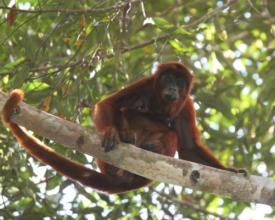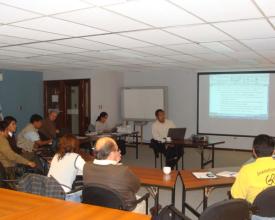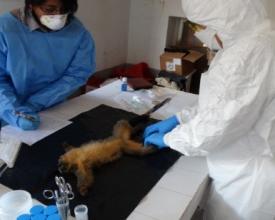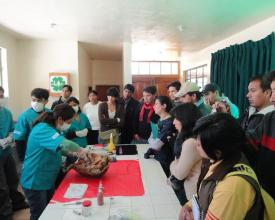
Monitoring for zoonotic viruses in wild animals to prevent disease outbreaks in Bolivia
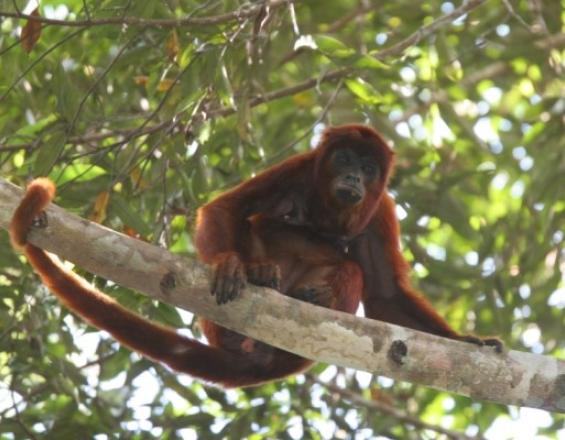
From 2010 to 2013, wildlife disease monitoring capacities were enhanced by the USAID Emerging Pandemic Threats Program´s PREDICT project in Bolivia within a One Health approach. Collaborative work with government agencies for field investigations, risk detection and prompt response were promoted; key stakeholders were trained on wildlife disease surveillance; and diagnostic capacities were enhanced in local laboratories. As a result, in 2012 trained staff reported a mortality event affecting red howler monkeys (Alouatta sara). The outbreak investigation confirmed Yellow Fever Virus, a flavivirus transmitted by mosquitoes that aggressively affects neotropical non-human primates and may cause acute and often fatal disease in humans. Effective communications between the PREDICT team and the national health authorities allowed a prompt alert and the rapid implementation of actions to prevent human cases, including vaccination of at risk human population, public education and outreach, and mosquito-control.
Context
Challenges addressed
In Bolivia, as in many developing countries, health systems are more reactive than preventive, therefore, control measures are usually applied once an outbreak is detected. Despite their importance to predict potential high-risk health events to human populations, surveillance systems to monitor disease in wildlife are rarely implemented. Lack of awareness, training, knowledge, and insufficient diagnostic and financial resources to monitor wildlife health events limit the possibility of collecting proper samples and test them to detect wildlife diseases, including zoonosis. Furthermore, collaboration channels across sectors are rarely optimum, reducing the overall capacity to respond to zoonotic outbreaks of wildlife origin.
Location
Process
Summary of the process
People working and/or living near wildlife in regions of high-risk for the emergence of diseases, was trained to promote wildlife diseases surveillance. In parallel, support was provided to increase local laboratories capacities, enhancing prompt detection and identification of pathogens of zoonotic potential in wildlife. Communication channels and trust among collaborators were crucial to facilitate the rapid flow of information so that prompt investigations during potential epizooties events can be activated. The collaboration agreements and good relationships established during trainings and inter-sectorial meetings allowed that, based on the generated awareness and understanding of the importance of diseases investigation, costs were shared by the involved partners during the different phases of the investigation avoiding delays for the obtention and transport of specimens due to economic and staff limitations of a particular sector. Once obtained, PREDICT staff communicated the laboratory results to the health authorities and supported the risks analysis of the situation so that prompt strategies were adopted to contain the YFV outbreak and prevent the occurrence of human cases.
Building Blocks
Facilitate intersectoral cooperation
This building block involved facilitating dialogues between previously siloed actors: government agencies, research, local people, etc. When the gaps between sectors are addressed before solution implementation, diverse voices and opinions can be considered and the solutions developed are often more readily implemented and accepted.
Enabling factors
All actors need to be open to collaboration, feedback, and input from sectors they may not have considered relevant to past projects.
Lesson learned
Having a leading organization (the Wildlife Conservation Society in Bolivia) with a long history of work in the country, with a well based experience and good institutional relationships established, was crucial to facilitate the rapid implementation and good development of the PREDICT project activities. During the time that PREDICT was working in Bolivia (from 2010 to 2013), efforts were done to facilitate the establish a national Zoonoses Surveillance Plan where the Ministry of Health, the National Veterinary Service and the General Directorate of Biodiversity could ensure a permanent and sustainable collaboration among sectors to prevent zoonotic diseases in the country. Unfortunately, this goal couldn´t be accomplished in the project period, nevertheless, the basis for such collaborative framework were established and many inter-institutional and multi-disciplinary collaborations to investigate further non-human primates yellow fever events and rodent-borne diseases, took place in the following years as a result.
Training on wildlife disease surveillance tools
Key stakeholders (including government personnel from public health, veterinary and biodiversity services; wildlife rescue centers staff; field veterinarians; biologists; laboratory technicians; and inhabitants of indigenous communities), were trained to survey for zoonotic disease spillover risk using the USAID PREDICT surveillance protocols. Training covered diverse topics including biosafety and PPE use, animal capture, sampling methods for various species of animals, data collection, sample packing and shipment, emergency preparedness, early warning systems, and safe laboratory operations. Woven into all training on surveillance tools was the emphasis on clear communication channels. All stakeholders were made aware of the specific agencies and individuals to liaise with regarding wildlife disease risk, so that the appropriate parties can be notified in a timely and effective manner.
Enabling factors
In Bolivia, English is little spoken by public servers and community members, thus, having local trainers providing training in Spanish was fundamental to facilitate the learning process. Applying a One Health lens to the training broadened the surveillance system to include stakeholders that had not been a part of the process previously. This more inclusive approach from the early point of training resulted in an effective disease surveillance system.
Lesson learned
In countries where education and actualization possibilities are limited, especially on novel topics such as wildlife health and surveillance, providing training possibilities to different stakeholders was a good strategy to generate local human capacities and awareness, while engaging people from different sectors and geographic areas to help on wildlife diseases surveillance. Following these trainings, the appropriate stakeholders were empowered with an understanding of what to do when wildlife is experiencing a disease event, who should take samples, the safety methods to implement, and the proper channels of communication. By implementing multi-disciplinary, inter-sectorial and inter-institutional trainings, dialogue, good communication and long-term collaborations among the diverse project´s partners from different sectors were facilitated, while the inclusion of the public health sector enabled the quick and efficient response to prevent a spillover event during the yellow fever epizooty detected on howler monkeys.
Enhance local laboratory diagnostic capacities
In order to facilitate the detection of potential pathogens on samples collected during the PREDICT surveillance activities, low-cost viral family-level consensus PCR assays were implemented at PREDICT´s local partner laboratory (IBMB) for detection of 12 different viral families of public health importance in wildlife. Also, to increase the diagnostic capacity of the Ministry of Health reference laboratories, CENETROP and INLASA, both laboratories received the PREDICT PCR protocols to detects prioritized families of viruses of zoonotic potential (coronaviruses, hantaviruses, flaviviruses, arenaviruses, alphaviruses, paramyxoviruses, bunyaviruses, filoviruses, henipaviruses, orthomyxoviruses, poxviruses and rhabdoviruses). In addition, primers and synthetic universal controls were donated to those laboratories for the detection and discovery of known and novel viruses in wildlife.
Enabling factors
The existence of laboratories with technical and physical capacities to run PCR tests in wildlife samples under save conditions, is crucial. Laboratory technicians should be interested and willing to implement new protocols and do research in collaboration to the field staff so that results can be properly interpreted.
Lesson learned
Rapid detection and identification of pathogens is fundamental to prevent diseases at the wildlife-human interphase. Thus, establishing local laboratory capacities and identifying strategies for its sustainability in developing countries has to be a priority in any strategy aiming to improve human and animal (including wildlife) health.
Wildlife disease surveillance at key interfaces
Wildlife disease surveillance in bats, rodents and non-human primates, was conducted in key interfaces where wildlife was most likely to interact (directly or indirectly) with livestock or humans. In Bolivia, key interfaces between wildlife and domestic animals and people included subsistence hunting by indigenous communities, captive wildlife settings (rescue centers and sanctuaries), peri-domestic settings (in and around human dwellings or fields), wildlife trade, extractive industries and livestock production areas. Additionally, wildlife disease surveillance was conducted in remote protected areas for comparison purposes, as well as during zoonotic disease outbreaks in people. By targeting healthy free-ranging wildlife and stressed or sick wildlife, we aimed to increase the possibilities of detecting known and novel viruses likely to impact human health and affect wildlife conservation.
Enabling factors
To cover the different wildlife-human interphases identified, collaboration of trained stakeholders on wildlife diseases surveillance was fundamental. In some indigenous territories, sanctuaries and wildlife rescue centers, trainees collected wildlife samples and surveillance data as part of their rutinary activities. It was trained staff from a wildlife sanctuary, who detected and immediately notified a howler monkey mortality event, resulting in a prompt and efficient response when the mortality event occurred, preventing a spillover to the human population.
Lesson learned
Prioritizing key interfaces where spillover could occur when carrying out disease surveillance creates the highest return on lowered risk. While surveillance cannot occur in every corner of a forest ecosystem, the areas in which humans could interact with wildlife inherently have the highest risk. By targeting surveillance efforts risk managers can capture the most pertinent information and create the most effective early warning systems. With proper surveillance systems in place, the Howler monkey mortality event was rapidly identified and the appropriate notification system was enacted.
Impacts
The working strategies adopted by the USAID Emerging Pandemic Threats Program’s PREDICT project in Bolivia were based on generating local capacities in wildlife surveillance methods for a wide range of participants, facilitating intersectoral cooperation, and increasing local diagnostic laboratory capacities. As a result, detection of the first epizootic of yellow fever in non-human primates from Bolivia was identified by its prompt investigation (only eight days elapsed from the outbreak notification to laboratory confirmation of the virus). Effective intersectoral communication channels established allowed an early notification and implementation of an effective response by local health workers consisting on vaccination campaigns, public health education and mosquito control in the surrounding areas, resulting in no human cases reported. Coordinated efforts to identify and respond to the detected YFV demonstrated the importance of monitoring for zoonotic viruses in wild animals as a valuable early detection tool for preventing disease outbreaks, particularly in landscapes undergoing substantial alteration, such as deforestation, where breakdown of natural barriers leads to increased contact between wildlife and people.
Beneficiaries
People living in areas with accelerated land use changes, including Indigenous communities.
Human and animal health servers.
Local diagnostic laboratories technicians.
A wide range of stakeholders trained in wildlife health surveillance methods.
Wildlife.
